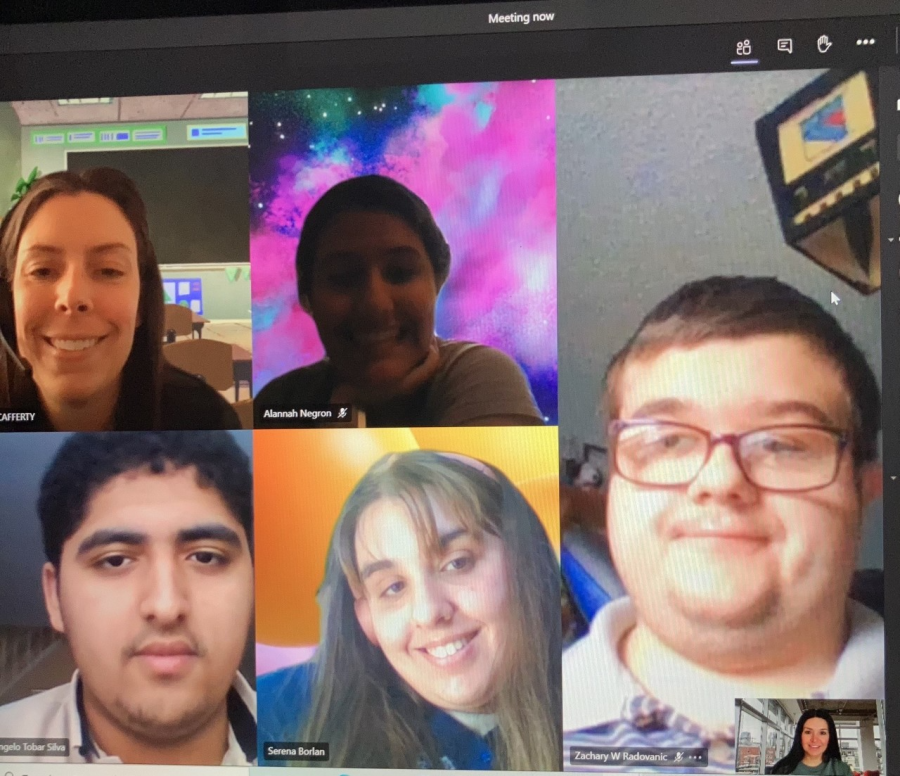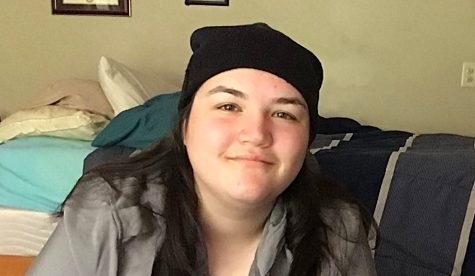An Interview with Ms. Cafferty
Whether online or in E-Hall, Ms. Cafferty and her students have been hard at work with a multi-faceted project that is sure to have many positive repercussions in the future. Developed in response to the learning challenges presented by the Coronavirus pandemic, the ambitions of this particular project stretch far beyond Teams meetings and into the future. In this interview, Ms. Cafferty delves into specifics.
Ms. Cafferty along with an assembly of some of her students. “The way your mind is wired won’t stop you from making your dreams come true!” says Serena Borlan, 12, ecstatic about the project.
February 2, 2021
Q: WHAT IS THE PROJECT?
A: So, in the fall, my students actually worked on an assignment where they researched disabilities, and part of the assignment was researching what particular disability, how it presents itself, what some of the treatments are, and particularly what the modifications for these students are, particularly beyond high school and at a job. And then part of that assignment was to discuss and research different people with these disabilities who have become successful in their lives with appropriate supports.
Q: SO IT’S LIKE INSPIRATION?
A: Yeah, a little inspiration, and also a big part of it is that all the students in the room have some form of disability and it kind of provided them with more information about how many more people in the world actually have a disability, whether it’s something like ADHD or more of a physical disability. It really opened their eyes to how just in the high school alone -outside of special education- how many students have a disability that they learn how to maneuver around or set up supports. I also think it taught the students how to have conversations with their peers. It allowed the students to shift the dialogue to a more positive light; you know, what are some of the positives of any given disability? It’s empowering, and also just using information to open up a conversation with people around you.
Q: WAS THERE A PARTICULAR INSPIRATION TO START CRAFTING THIS PROJECT?
A: Well, these students would actually go out into the community: there’s a program where students go out and sample jobs within the community, and due to Coronavirus we couldn’t go out. So, we wrote up some new curricula this summer, and this was one of our units in class. Disability Research. And a large part of the class is teaching students to be advocates for themselves, both now and when they graduate and get a job.
Q: IT SOUNDS LIKE A CLASS THAT WILL HAVE A GREATER IMPACT ON MANY LIVES, AND TO HELP THE MORE NEUROTYPICAL OR ABLE-BODIED TO GAIN A DIFFERENT PERSPECTIVE, TO OPEN A DIALOGUE.
A: Yeah, definitely, and oftentimes I feel like we’re nervous to have that discussion, but we shouldn’t be. Do you recall the school store last year?
Q: YES, I DO!
A: These are the students that were working at the school store.
Q: AND THE GOAL OF THIS PROJECT WAS?
A: To practice job skills. In the classroom, what you didn’t see was that they would take inventory of all the items and learn how to communicate with students walking up to the store. They worked the cash register. If you saw that they were selling T-shirts, the students were actually making those shirts in class.
Q: HOW HAS THIS CLASS CHANGED OTHER ASPECTS OF YOUR LIFE?
A: I feel like my experiences within the class have definitely taught me to be a more patient person in general, and I think that my experiences in the classroom as far as finding new ways to teach students has also benefited me when it comes to explaining things on the lacrosse field.
With the main goal of opening potentially uncomfortable dialogues, the student’s research into all the aspects of any given disability strives to promote understanding and empowerment. Ms. Cafferty has extended the offer to any student who may have questions about these kinds of things, in the hopes of having those discussions. She can be reached at [email protected].



